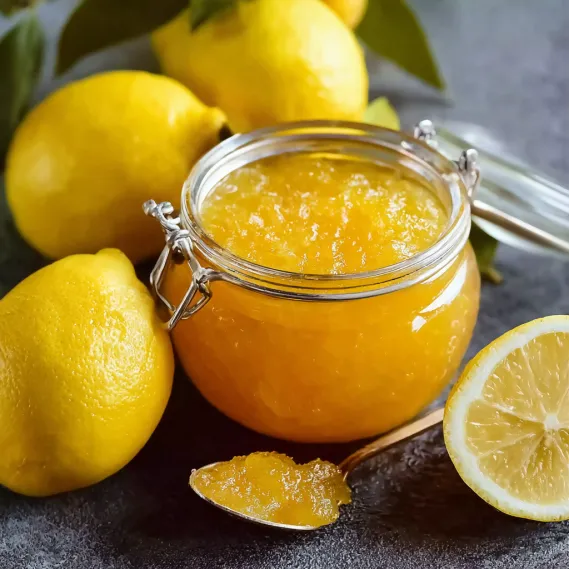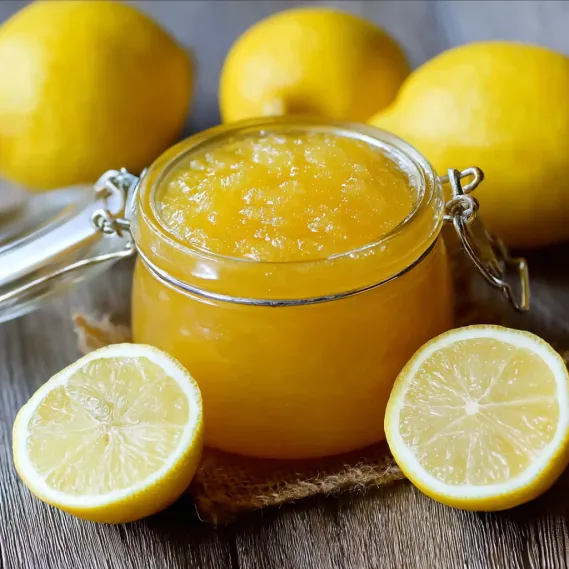 Pin
Pin
This tangy Italian lemon jam captures the bright essence of fresh lemons in a spreadable treat that's perfect for morning toast or an elegant addition to desserts. The balance of sweet and tart creates a versatile condiment that brightens everything it touches.
I first made this jam when my lemon tree produced an overwhelming harvest one spring. What began as a practical solution to avoid waste has become a family tradition. My daughter now requests a fresh batch whenever the winter sniffles appear, convinced it keeps colds at bay.
Ingredients
- Fresh lemons: Selected for their bright yellow color and slight give when squeezed for maximum juice yield
- Granulated sugar: Which not only sweetens but helps preserve the jam and create the proper consistency
- Water: To help dissolve the sugar and create the right consistency for the jam
- Vanilla extract: Optional but adds subtle warmth and depth to the bright citrus flavor
How To Make Italian Lemon Jam
- Prepare the lemons:
- Thoroughly wash and dry the lemons to remove any wax or residue. Using a microplane or fine grater, carefully remove just the yellow zest, avoiding the bitter white pith beneath. Next, cut the lemons in half and juice them, straining out any seeds and pulp if you prefer a smoother jam.
- Create the base mixture:
- In a medium-sized heavy-bottomed pot, combine the fresh lemon juice, zest, granulated sugar, and water. Stir with a wooden spoon until the sugar completely dissolves into the liquid, creating a translucent mixture before applying any heat.
- Simmer to perfection:
- Place the pot over medium heat and bring the mixture to a controlled boil. Once bubbling, reduce to a gentle simmer and cook for 30-40 minutes. The liquid will gradually reduce and thicken, transforming from watery to glossy and viscous. Stir occasionally to prevent scorching and check the consistency regularly.
- Test for doneness:
- The gel test is crucial for perfect jam consistency. Place a small plate in the freezer before you begin cooking. When you think the jam might be ready, drop a small spoonful onto the cold plate and return to the freezer for one minute. Run your finger through the jam. If it wrinkles and holds a clear path, your jam has reached the setting point.
- Jar and preserve:
- Remove the finished jam from heat and let it cool slightly for about 5 minutes. If using the optional vanilla, stir it in now. While still hot, ladle the jam into sterilized glass jars, leaving about ¼ inch headspace. Secure with clean lids and allow to cool completely before storing.

Lemons have been my secret weapon in the kitchen since I learned to cook. Their bright acidity cuts through richness and wakes up flavors like nothing else. My grandmother made a version of this jam that she called "sunshine in a jar" during the dark Italian winters, claiming it kept melancholy at bay.
Serving Suggestions
This versatile lemon jam shines in numerous culinary applications beyond the expected morning toast. Try spreading it between layers of a vanilla cake for a surprising burst of citrus, or serve alongside a cheese board where it pairs magnificently with creamy brie or sharp aged cheeses. For an elegant breakfast, swirl a spoonful into plain Greek yogurt with a sprinkle of granola, or use as a topping for panna cotta or vanilla ice cream for a simple yet sophisticated dessert.

Storage Tips
For everyday use, store your sealed jars of lemon jam in the refrigerator where they'll keep beautifully for up to three weeks. If you'd like to preserve your jam for longer periods, you'll need to process the jars using proper water bath canning techniques. Properly canned jars can be stored in a cool, dark pantry for up to one year. Once opened, always keep refrigerated. The high acid content of lemons combined with sugar makes this jam naturally resistant to spoilage, but always check for any signs of mold before using.
Historical Context
Lemon preserves have deep roots in Italian culinary tradition, particularly in southern regions like Sicily and along the Amalfi Coast where lemon trees thrive in the Mediterranean climate. This style of jam originated as a practical way to preserve the winter citrus harvest for use throughout the year. In traditional Italian households, nothing went to waste, and citrus preservation became an art form. Beyond jam, Italians created limoncello, candied peels, and preserved lemons, celebrating the fruit's versatility. This recipe honors that tradition while adapting to modern kitchens.
Ingredient Substitutions
If you're looking to experiment or accommodate dietary needs, consider these thoughtful substitutions. Meyer lemons can replace regular lemons for a sweeter, less acidic jam with beautiful floral notes. For those monitoring sugar intake, honey can substitute for up to half the granulated sugar, though this will alter the setting properties and shelf life. Adding a tablespoon of fresh rosemary or thyme during cooking creates an herbaceous variation perfect for pairing with savory dishes. For special occasions, a splash of limoncello or grappa added after cooking infuses the jam with sophisticated complexity.
Recipe FAQs
- → What kind of lemons work best for this jam?
Fresh, organic lemons are ideal as they provide the best flavor and ensure no wax or pesticides interfere with the zest.
- → How do I achieve the right consistency?
Simmer the mixture until thickened and test by placing a small amount on a cold plate. If it gels, it’s ready.
- → Can I reduce the sugar in this jam?
Yes, but keep in mind that sugar not only sweetens but also helps with preservation and texture. Adjust accordingly.
- → What’s the best way to sterilize jars?
Wash the jars in hot, soapy water, then sterilize them in boiling water or in the oven to ensure food safety.
- → How long does the jam stay fresh?
Sealed jars can remain fresh for up to 12 months when stored in a cool, dark place. Once opened, refrigerate and consume within a month.
